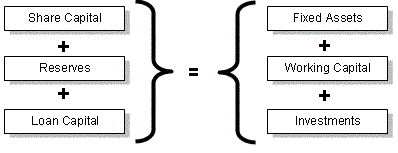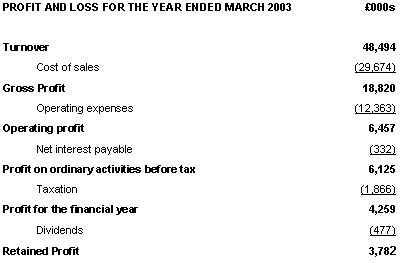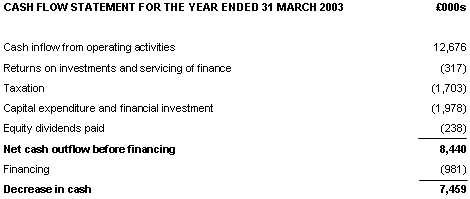
Ian McIsaac
Financial Training and Consultancy
| Home | Services | Learning Centre | Course Schedule | Clients | CV | Contact |
Back to main menu
1. |
Financial Statements Overview |
|
1.1 |
Introduction |
|
| Welcome to this guide to financial statements and company accounts.
It is intended as a step-by-step guide to take you through the contents of company reports. It explains the purpose of financial statements and how they can be used to assess the performance of a company. There is also a chapter on the regulatory issues governing the preparation of financial information in the UK. The guide is also recommended as pre-course reading for those intending to participate in Ian McIsaac’s Finance for Non-Financial Manager programme or for the Foundation Course in Corporate Credit. We shall begin by looking at the three key financial statements:
the balance sheet, the profit and loss and the cash flow statement.
|
||
1.2 |
The Balance Sheet |
|
The balance sheet is a snapshot of the financial position of
a business at a particular point in time. It reveals two important
pieces of information about the business at the moment when the
snapshot is taken. It shows: |
||
 |
||
1.2.1 |
The Sources of Funds |
|
| There are three key sources of funds: Share Capital - These are funds invested by the shareholders, or owners, of the business. In return, the owners receive shares which are the basic units of ownership of the business. Reserves - Reserves are profits made by the company which have been ploughed back in to the business. There are other types of reserves which are discussed in chapter three. Loan Capital - This is money obtained by borrowing. Borrowings are liabilities which have to be repaid at some point in the future. |
||
1.2.2 |
How the Money has been Spent |
|
| There are also three areas where the company can use the funds: Fixed Assets - These are items held on a continuing basis in order to generate wealth for the company in the future e.g. buildings, vehicles, plant and equipment. Working Capital - Working capital items are not held permanently. One example is stock purchased from a supplier. Stock is usually held for a period of time before being sold to a customer. Working capital consists of a number of different items. These are discussed in more detail in chapter three. Investments - These usually represent shares acquired in other companies. |
||
1.3 |
Profit and Loss (also known as the Income Statement) |
|
| The profit and loss account shows the total revenue generated by
a business and the total expenses incurred in generating that revenue.
Unlike the balance sheet, it is not a snapshot but rather shows the
revenues and expenses of a business over the course of a financial
period.
The format of the profit and loss varies according to the type
of business to which it relates. A typical example is shown below: |
||
 |
||
| Turnover is another term for sales. It includes both cash sales
and sales of goods and services made on credit. The gross profit represents the company’s sales during the financial period less the costs of buying the goods that have been sold. Great care is taken when preparing accounts to ensure that the sales and the cost of making those sales are closely matched. Goods purchased during the financial period which are not to be sold until the following period will be ‘excluded’ from the cost of sales calculation. Operating profit is calculated after deducting from the gross profit figure the other expenses incurred in running the business. These expenses are often known as the overheads and include administration and selling expenses. Finally, the three financial expenses are deducted to arrive at the retained profit for the year. These expenses are the interest charges (i.e. the interest on the loan capital on the balance sheet), tax and dividends. Dividends are that part of profits paid to shareholders in proportion to the number of shares that they own. |
||
1.4 |
The Relationship between the Balance Sheet and the Profit and Loss |
|
| The profit and loss can be regarded as linking the balance sheet
at the beginning of the financial period with the balance sheet at
the end of the financial period. The balance sheet at the end of the
period will incorporate any extra profit shown on the profit and loss
account since the last balance sheet was prepared. If the reserves on the balance sheet stood at £1,000 at the beginning of the financial period and the company made a retained profit of £150 for the year, then this profit of £150 would be added to the reserves at the end of the period on the balance sheet. A company with a steady record of profitability is likely to be building up its reserves on the balance sheet as the years go by. This is why it is common to describe the balance sheet as showing the accumulated wealth of a company at a particular point in time. If, on the other hand, there is a steady record of losses the reserves of the company are likely to be diminishing. The word ‘reserves’ can be confusing. Reserves aren’t equivalent to a war chest of cash that the managers of the business can use at any time. Reserves belong on the side of the balance sheet showing the sources of funds to a business. The other side of the balance sheet reveals how these sources have been used. It is possible that the company may have used the retained profits to build up cash on the asset side of the balance sheet but it is more likely that it will have chosen to purchase other assets such as new factory equipment which will provide a greater return for shareholders than cash normally provides. |
||
1.5 |
Cash Flow Statement |
|
| The third financial statement is the cash flow statement. Its function
is to explain the cash movements in and out of the business over the
financial period. Cash is of critical importance to all businesses. It is cash – rather than profit - that pays the staff costs and repays the bank loans. There are a number of reasons why cash and profit are not the same thing. The profit and loss brings together all the income to be received and expenses payable for the year, regardless of whether or not cash has been received or paid for those transactions. For example, the cash flow statement would only show the cash received in respect of goods sold whereas the profit and loss shows all the sales made in the year whether the cash has been received or not. A simple cash flow statement is shown below: |
||
 |
||
| The cash flow statement starts by showing the cash generated from
day-to-day operating activities (it is useful to compare this figure
with the operating profit when analysing a business). The statement
above then shows the deductions for net interest expense (returns
on investments and servicing of finance), tax paid, funds spent on
the purchase of new fixed assets (capital expenditure) and the dividends
paid to shareholders during the year. The net position is then shown
after these deductions. Financing refers to external sources of finance, either loans or the issue of share capital. A positive figure indicates that external finance has been provided whereas a negative figure indicates that funds have been repaid, usually to banks. The Decrease in Cash shown at the foot of the statement refers to the change in the cash/overdraft position on the balance sheet from beginning of the year to the end of the year. |
||
| Back to main menu |